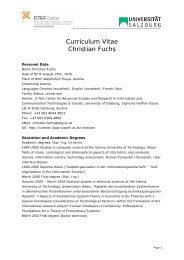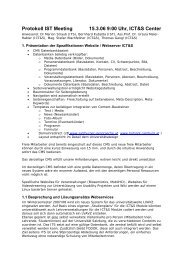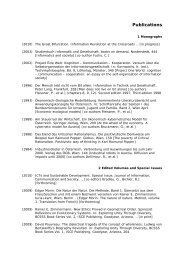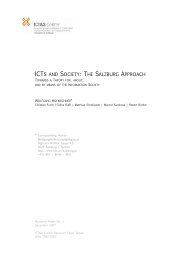CHRISTIAN FUCHS - ICT&S - Universität Salzburg
CHRISTIAN FUCHS - ICT&S - Universität Salzburg
CHRISTIAN FUCHS - ICT&S - Universität Salzburg
You also want an ePaper? Increase the reach of your titles
YUMPU automatically turns print PDFs into web optimized ePapers that Google loves.
Christian Fuchs: Social Networking Sites and the Surveillance Society9. Summary9.1. Theoretical FoundationsThere is a large interest in integrated social networking sites (ISNS) in the global Internetpublic. ISNS have become popular with the emergence of web 2.0 and web 3.0. Web1.0 is a computer-based networked system of human cognition, web 2.0 a computerbasednetworked system of human communication, web 3.0 a computer-basednetworked system of human co-operation. Online platforms such as MySpace orFacebook – which are the two most well known – are web-based platforms ofcommunication and community-building, i.e. web 2.0 and 3.0 systems. What makesthem distinct is that they are integrated platforms that combine many media andinformation and communication technologies, such as webpage, webmail, digitalimage, digital video, discussion group, guest book, connection list, or search engine.We find it therefore more appropriate to speak of integrated social networking sites(ISNS) than of social network(ing) sites. ISNS are web-based platforms that integratedifferent media, information and communication technologies, that allow at least thegeneration of profiles that display information that describes the users, the display ofconnections (connection list), the establishment of connections between users that aredisplayed on their connection lists, and the communication between users. ISNS arejust like all computer technologies web 1.0 systems because they reflect and displaydominant collective values of society that become objectified and are confrontingusers. They are web 2.0 technologies because they are used for communication andestablishing connections in the form of connection lists. ISNS are web 3.0 technologiesbecause they allow the establishment of new friendships, communities, and themaintenance of existing friendships.One can distinguish three different approaches of research about ISNS:1. Techno-pessimistic ISNS research2. Techno-optimistic ISNS research3. Critical ISNS researchTechno-pessimistic ISNS research approaches conclude that ISNS are dangerous andpose primarily threats for the users, especially kids, adolescents, and more generallyyoung people. One can also characterize this approach as victimization discourse.Techo-optimistic research about ISNS is a discourse of empowerment. It stresses thepotential of technology for autonomy, personal development, freedom, the formation,maintenance, and deepening of communities, love, or friendships. This discourseassesses ISNS fairly positive, it mainly sees advantages, and considers disadvantages asideological constructs or as minor issues. Critical ISNS research argues that the technopessimisticand the techno-optimistic approach do not focus on how ISNS areconditioned by the totality of society. Critical approaches analyze how ISNS usage isconditioned by the capitalist economy, the political system, and dominant culturalvalue patterns and conflicts.Electronic surveillance by nation states and corporations aims at controlling thebehaviour of individuals and groups, i.e. they should be forced to behave or not behavein certain ways because they know that their appearance, movements, location, orideas are or could be watched by electronic systems. After September 11, 2001,108









